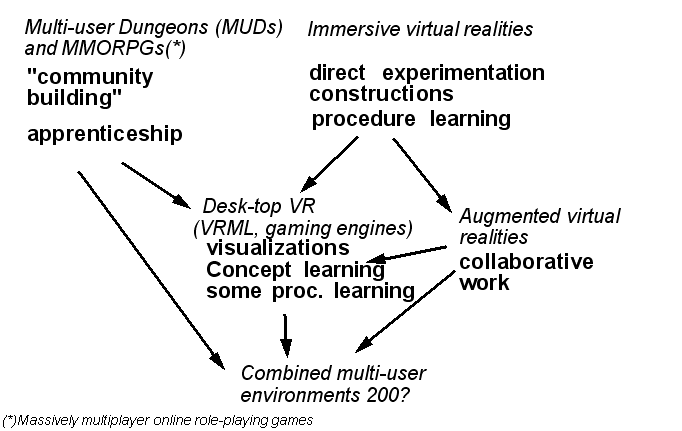Virtual environment
 From EduTechWiki - Reading time: 2 min
From EduTechWiki - Reading time: 2 min
Definition[edit | edit source]
This is a short overview entry with pointers to more specialized articles in this wiki. It also includes some general links and reference.
(Note: Maybe all these articles ought to be reorganized at some point - Daniel K. Schneider 25 August 2008)
A virtual environment is a "place" containing things that can be manipulated and people. It conveys a sense of presence.
Types of virtual environments (internal links you can follow up in random order):
- Shared spaces. Best to start with, since this entry shortly presents a more interesting taxonomy of virtual environments.
- text-based virtual reality, such as MOOs and MUDs
- Some Multi-user chat (MUC) systems, e.g. those that] add graphics and/or objects.
- Multi-user games with persistant storage features (mostly MMORPGs)
- Multi-user 2D interactive environments
- Multi-user 3D interactive environments with persistant storage capabilities, a multi-user variant of desktop virtual reality.
- Immersive 3D environments, i.e. true immersive virtual reality environments
- any other form of virtual habitats
- Collaborative virtual environments (CVEs) - this includes habitats like MUDs, MMORPGs as well as some CSCW systems.
- Virtual reality (immersive).
- Immersive virtual environments, i.e. a term that englobes various types of virtual and augmented realities.
- Mixed reality, i.e. the combination of augmented reality with virtual reality or desktop virtual reality.
See also related conceptual issues, e.g.:
History[edit | edit source]
See Raph Koster's excellent Online World Timeline
Typology of virtual environments[edit | edit source]
There is no real consensus on what constitutes a virtual environment. See also Benford's categorization of shared spaces.
Here is a picture made by DSchneider that shows a variety of such environments and their potential for education:
Examples[edit | edit source]
Links[edit | edit source]
- Designing Virtual Worlds Bibliography (excellent collection of online texts).
- Terra Nova (good blog to keep in touch with the latest trends in non-educational on-line worlds)
- There are some Wikipedia articles that include useful information, e.g.
- Habitat (video game) (Wikipedia).
- Virtual communities
- Cyberspace (Wikipedia)
- Virtual reality (Wikipedia, aliases from "virtual environment")
- simulated reality
- Association of Virtual Worlds publishes the free green (business guide) and blue (consumer) books.
- The blue book has a good long list of virtual environments (including ones for educational use). All kinds of technical environments are considered, most are desktop 3D. As of April 2009 its latest edition was: 5th Edition Jan 2009.
References[edit | edit source]
- Dieberger, A. (1999) Social connotations of space in the Design for Virtual Communities and Social Navigation. In Munro, A., Höök K. & Benyon D. (Eds), Social Navigation of Information Space, pp. 35-54. Springer: London
 KSF
KSF